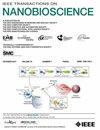ZebraVas: A Non-Invasive Microvision System for Vascular Recognition and Blood Flow Monitoring of Zebrafish Larvae
IF 4.4
4区 生物学
Q1 BIOCHEMICAL RESEARCH METHODS
引用次数: 0
Abstract
Zebrafish have emerged as a powerful model organism in cardiovascular disease research. Accurately identifying zebrafish blood vessels and evaluating blood flow velocity without injury has a wide range of biological applications. This paper presents the design and development of a non-invasive microvision system for vascular recognition and blood flow monitoring of zebrafish larvae. For the first time, a visual algorithm based on color thresholding and discrete Fourier transform filtering is proposed to determine the position of zebrafish dorsal cardinal vein vessels. Next, the blood flow velocity is determined based on the change rate of pixel values near the centroid point of the blood vessel recognition results. Then, an independent software system is developed based on the producer-consumer underlying framework. A user-friendly interface is specifically designed for biomedical workers, and a complete prototype system is built in combination with hardware devices. In addition, relevant experiments were conducted, and the results indicated that the system can effectively recognize the position of vessels and monitor blood flow velocity in zebrafish larvae under different anesthesia concentrations and developmental days. The heart rate information obtained based on blood flow velocity is consistent with the heart beating frequency. Moreover, the system has also been successfully applied to blood flow velocity monitoring under fluorescence conditions. In future work, this system will be applied in drug screening research for cardiovascular-related diseases of zebrafish larvae.ZebraVas:一种用于斑马鱼幼体血管识别和血流监测的无创微视觉系统。
斑马鱼已经成为心血管疾病研究的一个强有力的模式生物。准确识别斑马鱼血管并在不损伤的情况下评估血流速度具有广泛的生物学应用。本文介绍了一种用于斑马鱼幼体血管识别和血流监测的无创微视觉系统的设计与开发。首次提出了一种基于颜色阈值和离散傅里叶变换滤波的视觉算法来确定斑马鱼背主静脉血管的位置。接下来,根据血管识别结果质心点附近像素值的变化率确定血流速度。然后,基于生产者-消费者底层框架,开发了一个独立的软件系统。专门为生物医学工作者设计了用户友好界面,并结合硬件设备构建了完整的原型系统。此外,还进行了相关实验,结果表明该系统可以有效识别不同麻醉浓度和发育天数下斑马鱼幼体的血管位置和血流速度。根据血流速度得到的心率信息与心脏跳动频率一致。此外,该系统还成功应用于荧光条件下的血流速度监测。在今后的工作中,该系统将应用于斑马鱼幼体心血管相关疾病的药物筛选研究。
本文章由计算机程序翻译,如有差异,请以英文原文为准。
求助全文
约1分钟内获得全文
求助全文
来源期刊

IEEE Transactions on NanoBioscience
工程技术-纳米科技
CiteScore
7.00
自引率
5.10%
发文量
197
审稿时长
>12 weeks
期刊介绍:
The IEEE Transactions on NanoBioscience reports on original, innovative and interdisciplinary work on all aspects of molecular systems, cellular systems, and tissues (including molecular electronics). Topics covered in the journal focus on a broad spectrum of aspects, both on foundations and on applications. Specifically, methods and techniques, experimental aspects, design and implementation, instrumentation and laboratory equipment, clinical aspects, hardware and software data acquisition and analysis and computer based modelling are covered (based on traditional or high performance computing - parallel computers or computer networks).
 求助内容:
求助内容: 应助结果提醒方式:
应助结果提醒方式:


